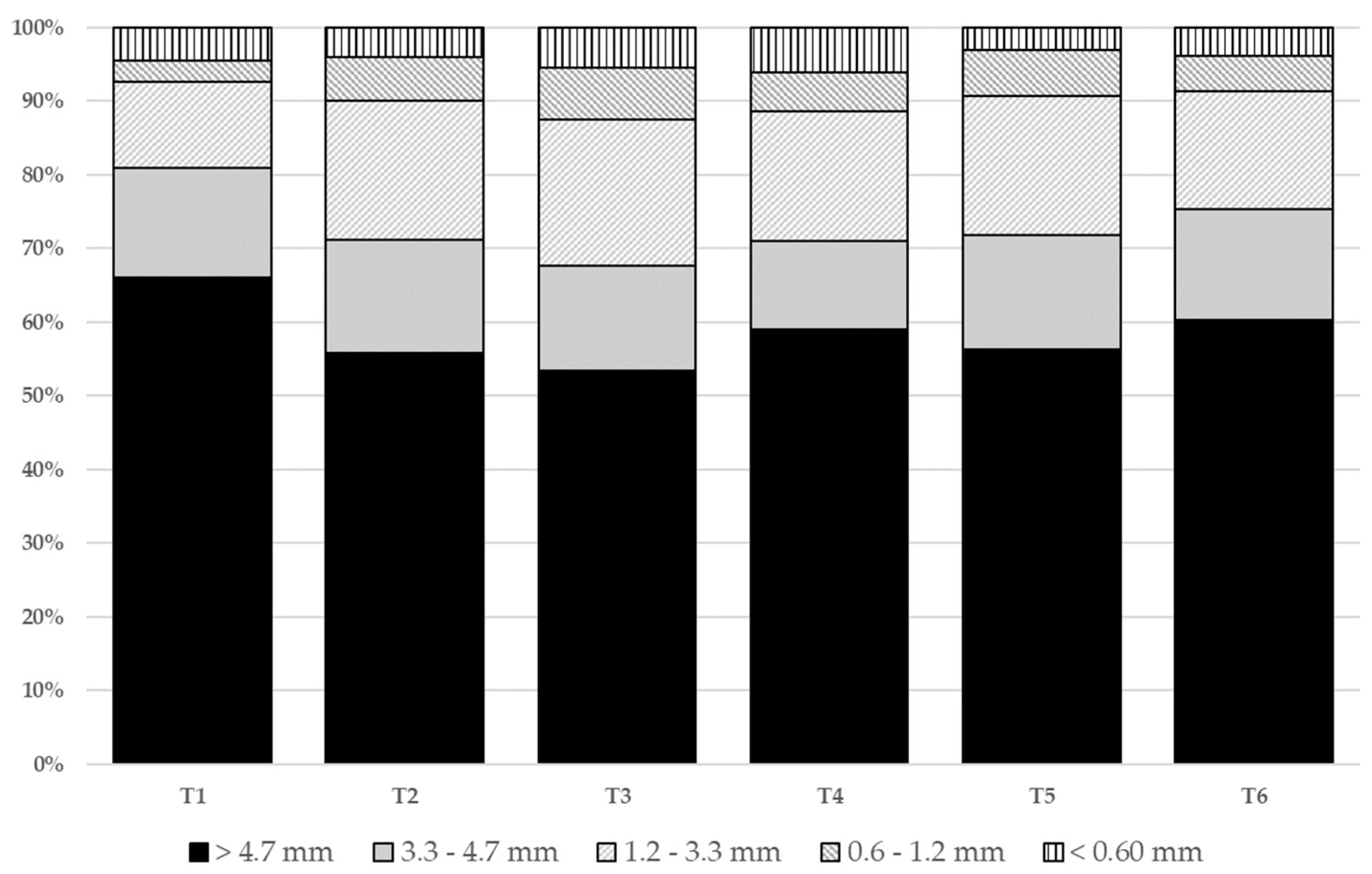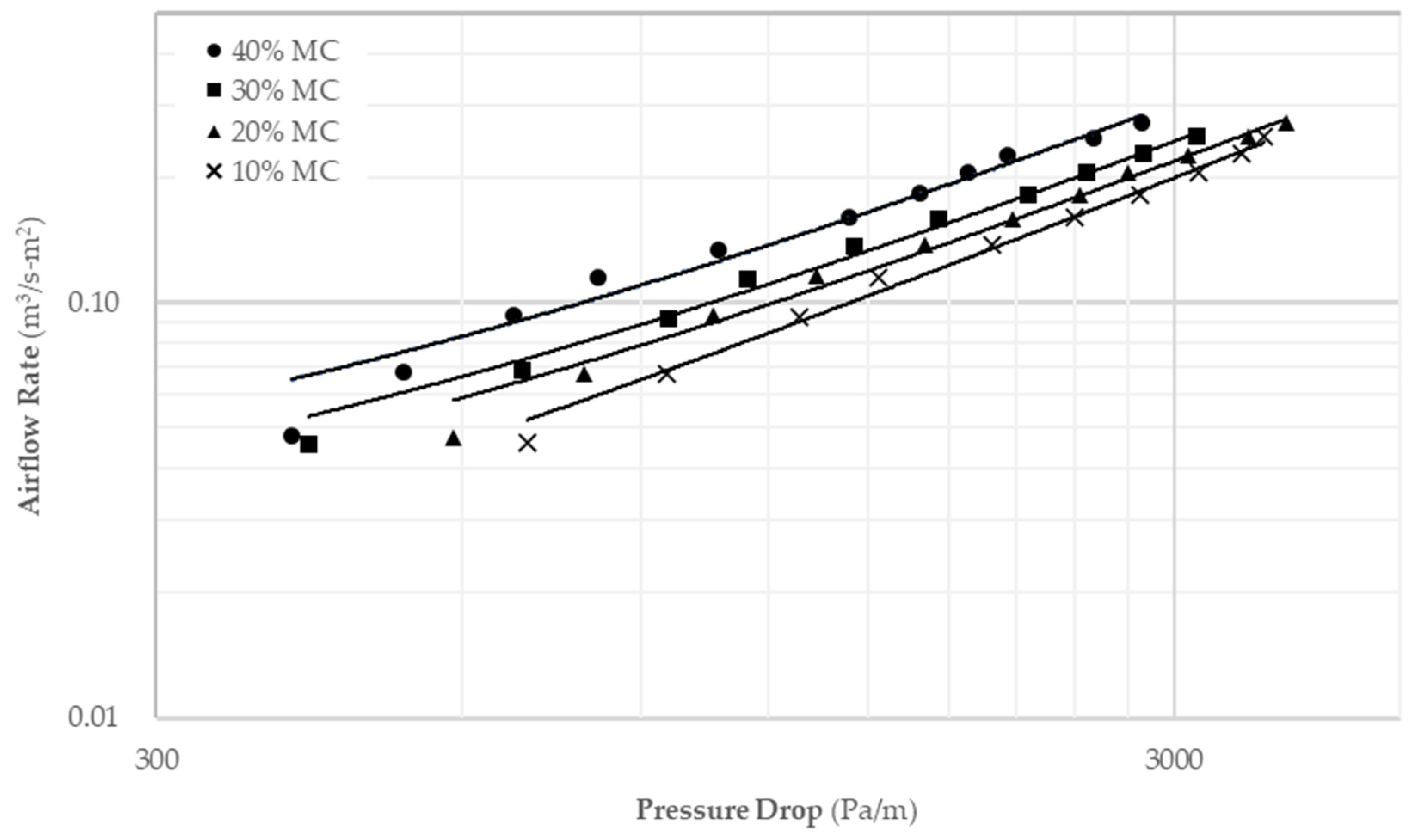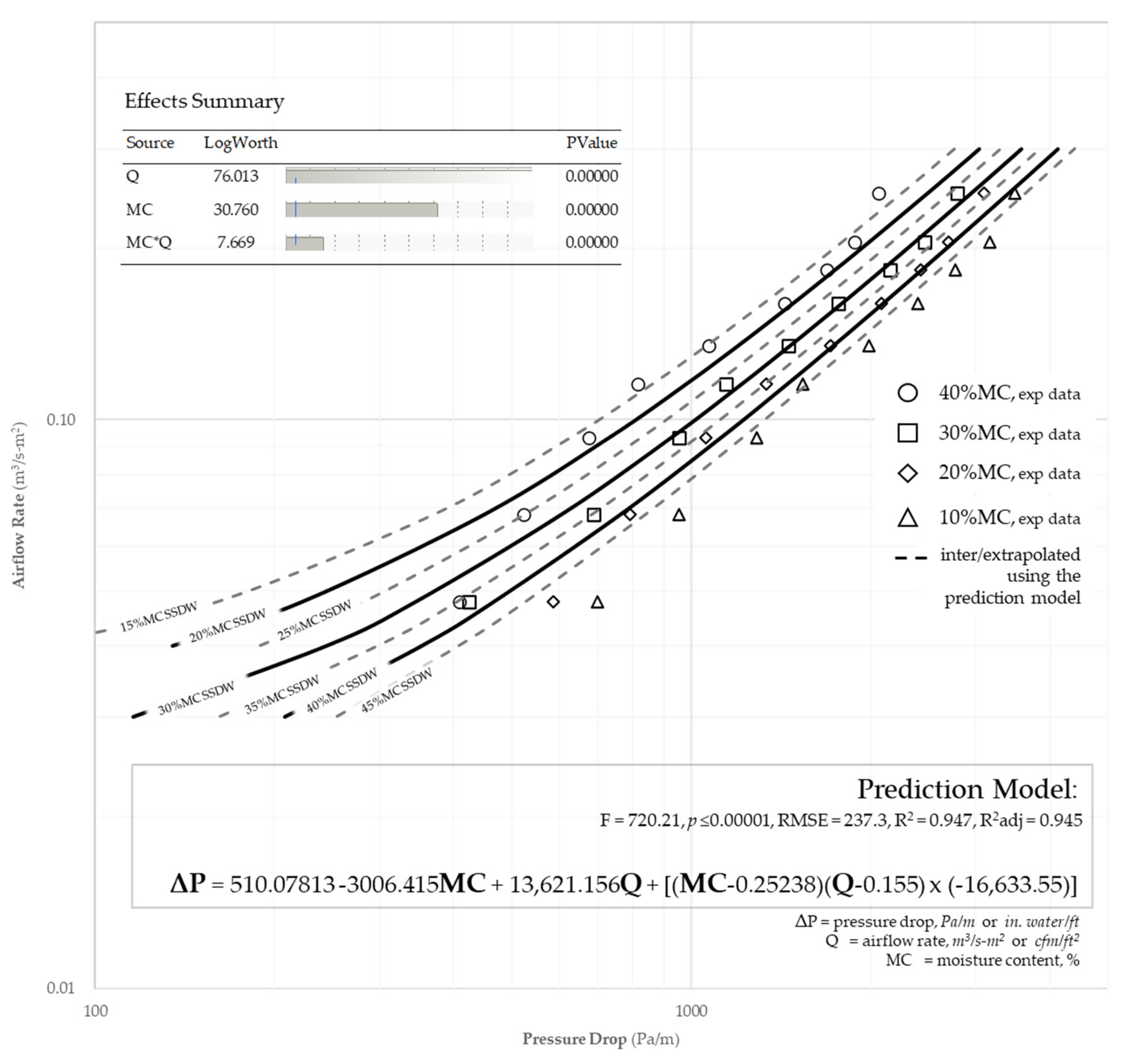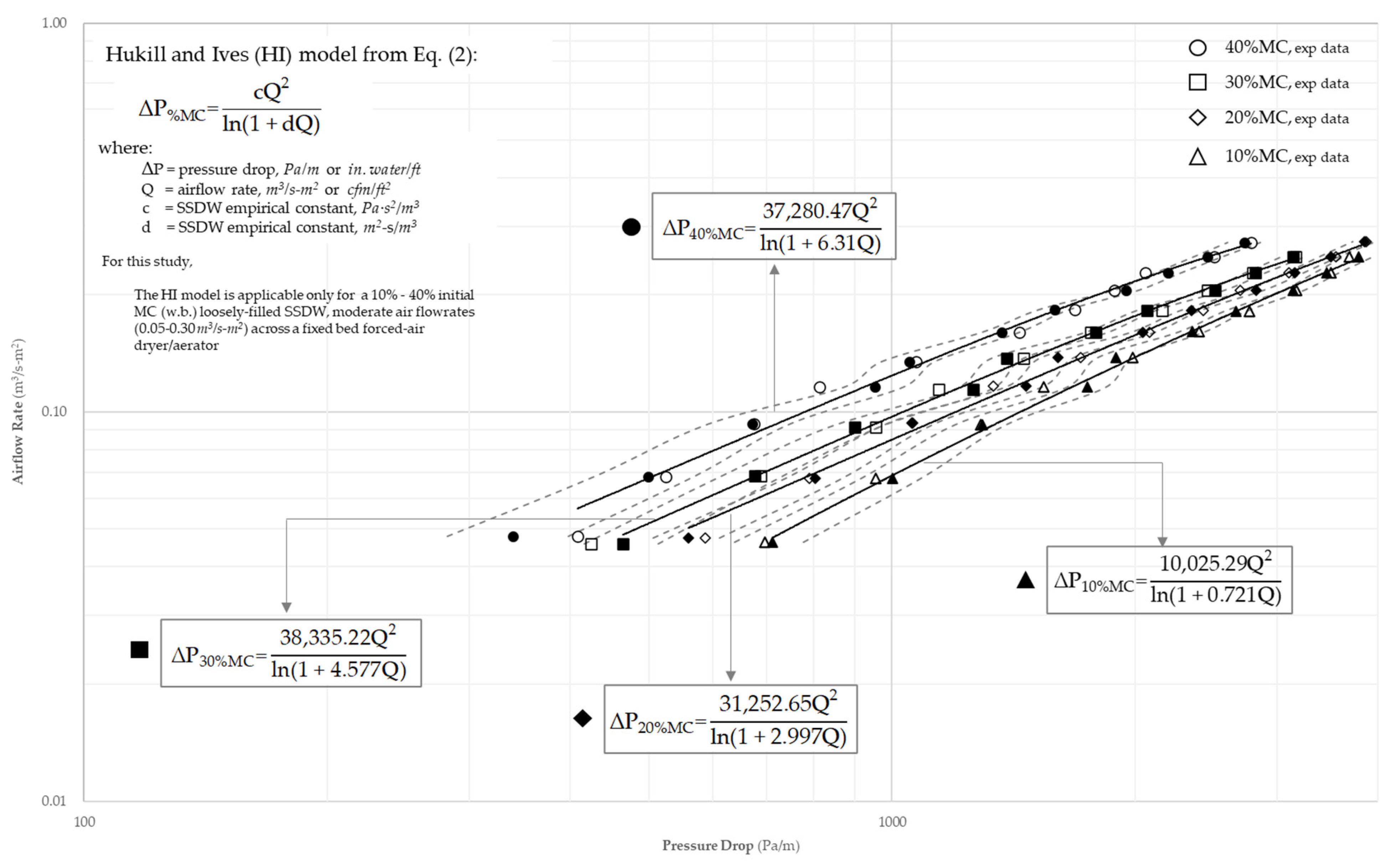Airflow Resistance of Solid-Separated Dairy Waste for Drying and Storage
Abstract
:1. Introduction
2. Materials and Methods
2.1. Material Collection and Preparation
2.2. Experimental Test Apparatus
2.3. Airflow Tests
2.4. Pressure Drop Analysis
3. Results and Discussion
3.1. Depth vs. Pressure Drop
3.2. Comparative Airflow Resistance of SSDW
3.3. Airflow Resistance at Different Moisture Levels
3.4. Airflow Resistance Model Fitting
4. Conclusions
Author Contributions
Funding
Data Availability Statement
Conflicts of Interest
References
- US Environmental Protection Agency. Risk Assessment Evaluation for Concentrated Animal Feeding Operations; EPA/600/R-04/042; US Environmental Protection Agency: Washington, DC, USA, 2004.
- Graham, J.; Nachman, K. Managing wastes from confined animal feeding operations in the United States: The need for sanitary reform. J. Water Health 2010, 84, 646–670. [Google Scholar] [CrossRef] [PubMed]
- Chapin, A.; Rule, A.; Gibson, K.; Buckley, T.; Schwab, K. Airborne multi-drug resistant bacteria isolated from a concentrated swine feeding operation. Environ. Health Perspect. 2005, 113, 137–142. [Google Scholar] [CrossRef] [PubMed] [Green Version]
- Gerba, C.; Smith, J. Sources of pathogenic microorganisms and their fate during land. J. Environ. Qual. 2005, 34, 42–48. [Google Scholar] [PubMed]
- Alcaraz, J.; Baticados, E.; Capareda, S.; Maglinao, A.; Nam, H. Drying and Pellet Characterization of Sand-Separated Dairy Manure from Stephenville, Texas, USA. Appl. Ecol. Environ. Res. 2017, 16, 29–38. [Google Scholar] [CrossRef]
- Mukhtar, S. Dairy Biomas as a Renewable Fuel Source. Agrilife Extension, Texas A&M System.L-5494. 2008. Available online: https://core.ac.uk/reader/4275426 (accessed on 20 February 2023).
- Schiavone, D. Understanding Farm Energy. University of Maryland Extension. 2020. Available online: https://extension.umd.edu/resource/understanding-farm-energy-fs-1138 (accessed on 22 February 2023).
- Capareda, S.C. Introduction to Biomass Energy Conversions, 1st ed.; CRC Press: Boca Raton, FL, USA, 2013. [Google Scholar]
- Sapariya, D.; Patdiwala, U.; Panchal, H.; Ramana, P.; Makwana, J.; Sadasivuni, K. A review on thermochemical biomass gasification techniques for bioenergy production. Energy Sources Part A Recovery Util. Environ. Eff. 2021, 1–34. [Google Scholar] [CrossRef]
- El-Mesery, H.; El-khawaga, S. Evaluation of the drying performance and energy analysis of different dryers. Case Stud. Therm. Eng. 2005, 33, 101953. [Google Scholar] [CrossRef]
- Gornicki, K.; Kaleta, A. Resistance of bulk grain to airflow—A review. Part I: Equations for airflow resistance. Ann. Wars. Univ. Life Sci. —SGGW Agric. 2015, 65, 31–41. [Google Scholar] [CrossRef]
- ASAE D272.3; Resistance to Airflow of Grains, Seeds, Other Agricultural Products, and Perforated Metal Sheets. ASABE: St. Joseph, MI, USA, 1996.
- Ergun, S. Fluid flow through packed columns. Chem. Eng. Prog. 1952, 48, 89–94. [Google Scholar]
- Gunasekaran, S.; Jackson, C. Resistance to Airflow of Grain Sorghum. Trans. ASAE 1988, 31, 1237–1240. [Google Scholar] [CrossRef]
- Shedd, C. Resistance of grains and seeds to airflow. Agric. Eng. 1953, 34, 616–619. [Google Scholar]
- Al-yahya, S.; Moghazi, H. Static pressure drop through barley grain. Can. Agric. Eng. 1998, 40, 213–217. [Google Scholar]
- ASTM D3173-11; Standard Test Method for Moisture in the Analysis Sample of Coal and Coke. ASTM International: West Conshohocken, PA, USA, 2011. [CrossRef]
- Karaeva, J.; Timofeeva, S.; Kovalev, A.; Kovalev, D.; Gilfanov, M.; Grigoriev, V.; Litti, Y. Co-pyrolysis of agricultural waste and estimation of the applicability of pyrolysis in the integrated technology of biorenewable hydrogen production. Int. J. Hydrogen Energy 2022, 47, 11787–11798. [Google Scholar] [CrossRef]
- Nalladurai, K.; Alagusundaram, K.; Gayathri, P. Airflow Resistance of Paddy and its Byproducts. Biosyst. Eng. 2002, 83, 67–75. [Google Scholar] [CrossRef]
- Dairo, O.; Ajibola, O. Resistance to airflow of bulk sesame seeds. J. Agric. Engng Res. 1994, 58, 99–105. [Google Scholar] [CrossRef]
- Grama, S.; Bern, C.; Hurburgh, C., Jr. Airflow resistance of mixtures of shelled corn and fines. Trans. ASAE 1984, 27, 268–272. [Google Scholar] [CrossRef] [Green Version]
- Sokhansanj, S.; Falacinski, A.; Sosulski, F.; Jayas, D.; Tang, J. Resistance of bulk lentils to airflow. ASABE Trans. 1990, 33, 1281–1285. [Google Scholar] [CrossRef]
- Kenghe, R.; Nimkar, P.; Shirkole, S.; Shinde, K. Airflow resistance in soybean. Int. Agrophysics 2012, 26, 137–143. [Google Scholar] [CrossRef]
- Dairo, O.; Oyenusi, A.; Aderinlewo, A.; Adetunji, O.; Adeleke, E. Modeling the airflow resistance of bulk sponge gourd (Luffa Cylindrica) seeds. LAUTECH J. Eng. Technol. 2018, 12, 1–9. [Google Scholar]
- Aderinlewo, A.; Raji, A.; Olayanju, T. Effect of moisture content on some physical properties of cowpea (Vigna unguiculata). J. Nat. Sci. Eng. Technol. 2011, 10, 133–145. [Google Scholar]







| MC Level | Actual MC (%) | Bulk Density, kg/m3 | Bulk Density, lb/ft3 |
|---|---|---|---|
| 10% | 9.60 ± 0.65 | 419.68 ± 29.95 | 26.20 ± 1.87 |
| 20% | 19.74 ± 1.17 | 381.71 ± 21.74 | 23.83 ± 1.18 |
| 30% | 30.99 ± 0.92 | 344.14 ± 23.18 | 21.48 ± 1.45 |
| 40% | 41.70 ± 1.55 | 296.40 ± 10.86 | 18.50 ± 0.068 |
| Moisture Content (% w.b.) | Shedd Parameters | R2 | RMSE | ||
|---|---|---|---|---|---|
| Nominal | Actual | a | b | ||
| 10% | 9.60 ± 0.65 | 0.0001044 | 0.945 | 0.997 | 95.555 |
| 20% | 19.74 ± 1.17 | 0.0002431 | 0.850 | 0.997 | 84.470 |
| 30% | 30.99 ± 0.92 | 0.0003538 | 0.815 | 0.997 | 67.752 |
| 40% | 41.70 ± 1.55 | 0.0005757 | 0.778 | 0.993 | 91.886 |
| Moisture Content (% w.b.) | Hukill and Ives Parameters | R2 | RMSE | ||
|---|---|---|---|---|---|
| Nominal | Actual | c | d | ||
| 10% | 9.60 ± 0.65 | 10,025.290 | 0.721 | 0.997 | 93.173 |
| 20% | 19.74 ± 1.17 | 31,252.654 | 2.997 | 0.997 | 80.447 |
| 30% | 30.99 ± 0.92 | 38,335.218 | 4.577 | 0.997 | 66.729 |
| 40% | 41.70 ± 1.55 | 37,280.474 | 6.313 | 0.998 | 85.955 |
Disclaimer/Publisher’s Note: The statements, opinions and data contained in all publications are solely those of the individual author(s) and contributor(s) and not of MDPI and/or the editor(s). MDPI and/or the editor(s) disclaim responsibility for any injury to people or property resulting from any ideas, methods, instructions or products referred to in the content. |
© 2023 by the authors. Licensee MDPI, Basel, Switzerland. This article is an open access article distributed under the terms and conditions of the Creative Commons Attribution (CC BY) license (https://creativecommons.org/licenses/by/4.0/).
Share and Cite
Baticados, E.J.N.; Capareda, S.C.; Mitchell, C.I. Airflow Resistance of Solid-Separated Dairy Waste for Drying and Storage. Energies 2023, 16, 5038. https://doi.org/10.3390/en16135038
Baticados EJN, Capareda SC, Mitchell CI. Airflow Resistance of Solid-Separated Dairy Waste for Drying and Storage. Energies. 2023; 16(13):5038. https://doi.org/10.3390/en16135038
Chicago/Turabian StyleBaticados, El Jirie N., Sergio C. Capareda, and Cole I. Mitchell. 2023. "Airflow Resistance of Solid-Separated Dairy Waste for Drying and Storage" Energies 16, no. 13: 5038. https://doi.org/10.3390/en16135038






